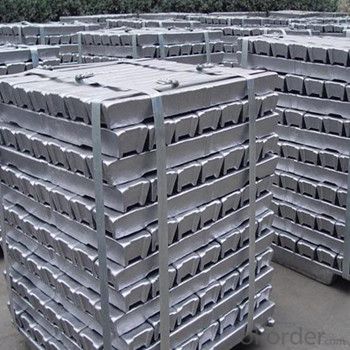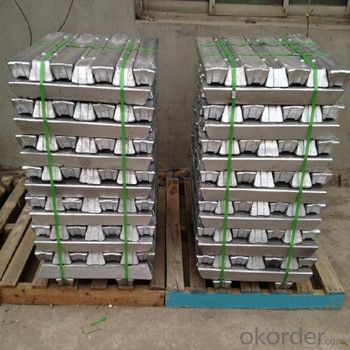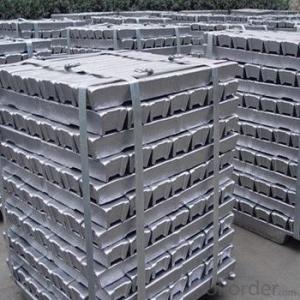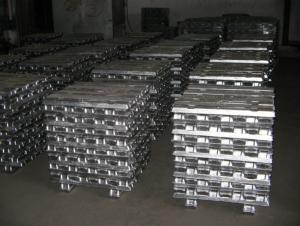Aluminum Pig/Ingot With 99.7% 99.9% Purity
- Loading Port:
- China main port
- Payment Terms:
- TT OR LC
- Min Order Qty:
- 1000 m.t.
- Supply Capability:
- 100000 m.t./month
OKorder Service Pledge
OKorder Financial Service
You Might Also Like
Pure Aluminum Pig/Ingot Used for Industry
1.Structure of Aluminum Pig/Ingot
A material that has been cast into a shape in order to be transported and processed easier than in an unprocessed form. An ingot is typically rectangular in shape, which allows it to be stacked. Ingots are most commonly associated with metals, with ingots of gold held in the vaults of banks and brokerages being popular images.
Aluminum Ingot is with the AL as the main chemical composition.Aluminum Ingot is used for industry,such as automobile,pinning and weaving,electron broadly and so on. Aluminum Ingot has the following advantages: easy control and operation, fast melting.
2.Main Features of the Aluminum Pig/Ingot
•High Purity
•Easy control and operation
•High strength
•Fast melting
•Competitive price
•Best Service
3.Aluminum Pig/Ingot Images


4.Aluminum Pig/Ingot Specification
Grade | Chemical Composition % | |||||||||
Al≥ | impurities ≤ | |||||||||
Si | Fe | Cu | Ga | Mg | Zn | Mn | others | Sum | ||
Al99.9 | 99.90 | 0.50 | 0.07 | 0.005 | 0.02 | 0.01 | 0.025 | - | 0.010 | 0.10 |
Al99.85 | 99.85 | 0.80 | 0.12 | 0.005 | 0.03 | 0.02 | 0.030 | - | 0.015 | 0.15 |
Al99.7 | 99.70 | 0.10 | 0.20 | 0.010 | 0.03 | 0.02 | 0.030 | - | 0.030 | 0.30 |
Al99.6 | 99.60 | 0.16 | 0.25 | 0.010 | 0.03 | 0.03 | 0.030 | - | 0.030 | 0.40 |
Al99.5 | 99.50 | 0.22 | 0.30 | 0.020 | 0.03 | 0.05 | 0.050 | - | 0.030 | 0.50 |
Al99.00 | 99.00 | 0.42 | 0.50 | 0.020 | 0.03 | 0.05 | 0.050 | - | 0.050 | 1.00 |
5.FAQ of Aluminum Pig/Ingot
We have organized several common questions for our clients,may help you sincerely:
①How about your company?
A professional manufacturers of the alumiun pig.Devoted in this industry for many years,so got much experice.The quality and service have also accepted by customer.Can meet customers' requiements to provide different grade and purity alumiun pig.
②How to guarantee the quality of the products?
We have established the international advanced quality management system,every link from raw material to final product we have strict quality test;We resolutely put an end to unqualified products flowing into the market. At the same time, we will provide necessary follow-up service assurance.
③How long can we receive the prod rking days, We will arrange the factory delivery as soon as possible. The pecific time of receiving is related to the state and position of customers.Commonly 7 to 10 working days can be served.
- Q: Who knows where needs aluminium ingot, aluminium powder, aluminium grain?
- 1. machinery raw materials factory.2. heat treatment smelting process.
- Q: What is the price of aluminum ingots in the market?
- Several factors, including supply and demand dynamics, global economic conditions, and market trends, can cause the price of aluminum ingots in the market to fluctuate. Based on my understanding, the typical price range for aluminum ingots is commonly between $1,800 and $2,200 per metric ton. Nevertheless, it is crucial to acknowledge that these prices are subject to modifications and may differ in various regions or at different periods. To obtain the most precise and current information, it is recommended to seek guidance from dependable sources such as metal industry reports, commodity exchanges, or aluminum sector market analysts.
- Q: How can the aluminum factory calculate the cost better?
- Cost of aluminum material = raw material price (futures aluminium ingot price) company's processing fee.
- Q: How is aluminium ingot made?
- Aluminium is a silvery white metal, second only to oxygen and silicon in the earth's crust, and ranks third. The density of aluminum is small, only 34.61% of iron and 30.33% of copper, so it is also called light metal. Aluminum is the world's output and consumption of ferrous metals only next to steel. The density of aluminum is only about 2.7103g/cm3, about 1/3 of the density of steel, copper or brass.
- Q: What are the main factors influencing the choice between aluminum ingots and aluminum wires?
- The main factors influencing the choice between aluminum ingots and aluminum wires are the intended use, cost, and convenience. Firstly, the intended use plays a significant role in determining whether aluminum ingots or aluminum wires are more suitable. Aluminum ingots are raw materials typically used in manufacturing processes, where they can be melted and cast into various shapes, such as sheets, bars, or profiles. They are commonly used in industries like construction, automotive, and aerospace. On the other hand, aluminum wires are primarily used for electrical applications, such as wiring systems, power transmission, and electrical components. Therefore, the specific purpose of the aluminum product needed will greatly influence the choice between ingots and wires. Secondly, cost is an important factor in decision-making. Aluminum ingots usually have a lower cost compared to aluminum wires. This is because ingots are the basic form of aluminum and require further processing to become wires, which involves additional manufacturing steps and costs. However, it is important to consider the overall project requirements, as using aluminum wires directly can save costs associated with additional processing and labor. Lastly, convenience also plays a role in the choice between aluminum ingots and aluminum wires. Aluminum wires are readily available in the market and can be easily purchased in various sizes and specifications. They are already in a usable form and can be directly installed or integrated into electrical systems. On the other hand, aluminum ingots may require additional processing, such as melting, casting, and shaping, before they can be used in a specific application. Therefore, if time and resources are limited, aluminum wires may be a more convenient choice. In conclusion, the main factors influencing the choice between aluminum ingots and aluminum wires are the intended use, cost, and convenience. Understanding the specific requirements of the project, considering the associated costs, and evaluating the convenience of each option will help in making an informed decision.
- Q: Can aluminum ingots be anodized?
- Yes, aluminum ingots can be anodized. Anodizing is a process that involves creating an oxide layer on the surface of aluminum, which can be done on both raw aluminum and aluminum alloys. This process enhances the metal's corrosion resistance, improves its appearance, and allows for coloring or dyeing options.
- Q: What are the different surface treatments for aluminum ingots?
- Depending on the desired outcome and application, there are various surface treatments available for aluminum ingots. Some commonly used treatments include: 1. Anodizing: By creating a protective oxide layer, anodizing offers corrosion resistance, durability, and improved aesthetic appearance. 2. Powder coating: This treatment involves applying a dry powder to the ingot's surface, which is then cured under heat to form a protective and decorative coating. It provides excellent resistance to corrosion, fading, scratching, and offers a wide range of color options. 3. Polishing: Achieved through mechanical buffing, polishing creates a smooth and glossy finish. It enhances the appearance and improves corrosion resistance. 4. Brushing: This treatment utilizes abrasive brushes to create a textured or brushed finish, often for decorative or industrial purposes. It also provides corrosion resistance. 5. Chemical etching: By selectively removing material from the surface, chemical etching can create intricate patterns, logos, or text. It is suitable for branding or decorative purposes. 6. Clear coat: Applying a clear coat adds an extra layer of protection against corrosion while preserving the natural appearance of the metal. Clear coats often contain additives that enhance longevity. To determine the most suitable surface treatment for aluminum ingots, it is important to consider the specific requirements of the application and seek advice from professionals in the field.
- Q: Is it harmful to the human body to refine ingots from waste capacitors?
- Solvents, solutes, and additives, such as ethylene glycol, glycerin, boric acid and ammonia, are used for a long time.
- Q: What is the average price of an aluminum ingot?
- The average price of an aluminum ingot can vary depending on various factors such as market conditions, supply and demand dynamics, and regional factors. As of [current date], the average price of an aluminum ingot is approximately [average price]. However, it is important to note that this price is subject to change and it is advisable to consult with industry sources or market experts for the most up-to-date and accurate pricing information.
- Q: How can I extract aluminium ingots from cans?
- If you want to sell, small and medium-sized aluminum factory will generally buy, but if you do not remove other components, and direct sell cans on the price is not much difference. When you first start, you certainly have little experience. When you have industry experience, consider whether you want to expand or not, and most importantly, how much you know about the industry.
Send your message to us
Aluminum Pig/Ingot With 99.7% 99.9% Purity
- Loading Port:
- China main port
- Payment Terms:
- TT OR LC
- Min Order Qty:
- 1000 m.t.
- Supply Capability:
- 100000 m.t./month
OKorder Service Pledge
OKorder Financial Service
Similar products
Hot products
Hot Searches
Related keywords




























